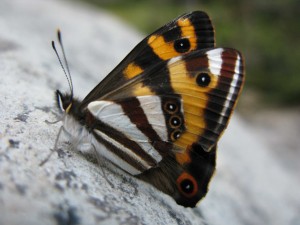This article was published in The Fringe, April 2013
The several Gahnia species are another family of plants essential to the health of a species of butterfly. Commonly called cutty grass or maru, Gahnias grow in many habitats - forest, swamp and coast - and are the specific host plants where the adult female of the rare forest ringlet butterfly (Dodonidia helmsii) deposits her eggs. Other species of ringlet tend to inhabit higher alpine places and the host plant species there are tussocks of the Poa and Chionochloa genera.
In Auckland, the coastal Gahnia lacera is, perversely, the least 'lacerating' of the several species. It grows to about 1.5 metres and cascades down coastal cliffs in an attractive manner with delicate flowering canes looking like weeping miniature bamboo. It generally grows under a light forest canopy so requires a well-drained soil and light shade in the garden.
The commonest forest species is Gahnia setifolia which is also the plant most frequently blamed for the cuts inflicted as you brush past. It is a 2 metre tall plant, again preferring shade, and it tolerates a wider range of soils from wet to quite dry.
At the wettest sites the largest species, Gahnia xanthocarpa, grows to 3 metres and is probably the most cutting of them all with leaves that have a strange gun-metal green-blue hue.
There are several other, less common, Gahnia species which may prove to be favoured by particular sub-species of ringlets. All the Gahnia are easy to grow once established, but they do not like being moved or having their roots disturbed, so planting is a risky time for them. But give them a go and enjoy the return of the forest ringlets when they come to visit.

Photo thanks to Dr Melissa Hutchison, Ecologist.

